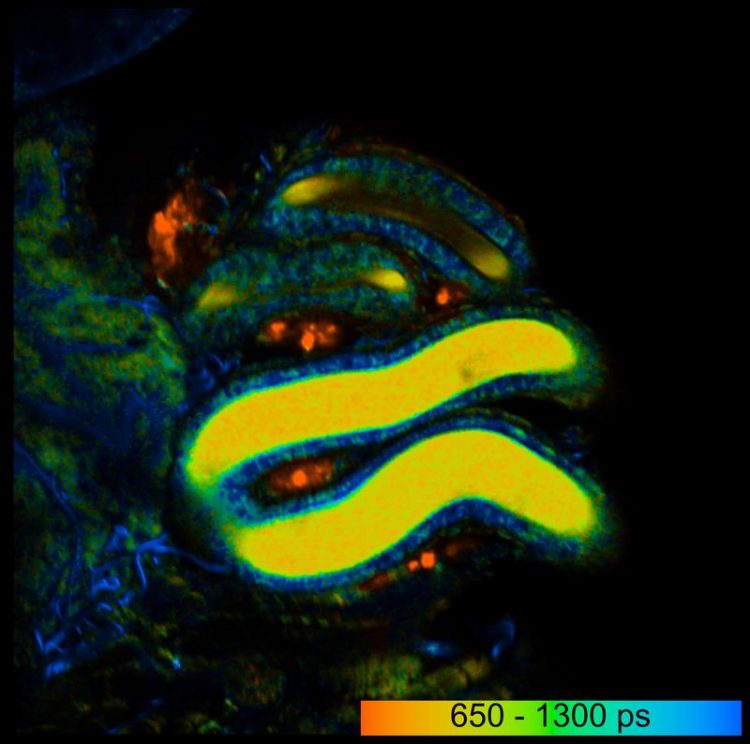Dresden biologists make living sperm glow

False-colour image of the fluorescence lifetime of the metabolic coenzyme NADH in sperm mass (here in yellow) in a female sperm storage organ in the fruit fly. Cornelia Wetzker
How do female insects manage to keep the sperm fresh for months after mating? This is a central question of the sperm biologists of the Chair of Applied Zoology headed by Prof. Dr. Klaus Reinhardt. Now the scientists presented their first promising results in the journal Scientific Reports.
Dr. Cornelia Wetzker borrowed an innovative label-free technique from cancer research in order to investigate the metabolism of living biological tissues.
This involves the measurement of the decay of the intrinsic fluorescence of the metabolic coenzyme NADH – a matter of nanoseconds, requiring a specialised microscope. This measure, also known as fluorescence lifetime, serves as a cell-specific signature and characterises the specific metabolic pathways of the tissue. Cancer cells have a shorter NADH fluorescence lifetime, are thus more glycolytic and can therefore be distinguished from healthy cells.
With this method, Dr. Cornelia Wetzker has now succeeded in examining the metabolism of intact tissues of the fruit fly outside the body. She analysed the metabolism of sperm in the storage organs of male and female animals as well as other tissues of the insect.
The sperm were investigated in still intact closed organs, which in the male serve for storage before and in the females after mating. The team thus found that the sperm had a highly glycolytic metabolism similar to that of cancer cells. Other cells, such as intestinal, gland and fat cells, were in a much more oxidative state.
Using this method, the biologists found a first clue to their initial question of how the sperm remain fresh in the body of the insect females. They discovered that the fluorescence lifetime of another autofluorescent metabolic coenzyme called FAD differs between the sperm in the male and in the female body.
With regard to the clinical application of this technique, fluorescence lifetime imaging microscopy (FLIM) is proving to be highly promising.
“The fluorescence lifetime signature analysis could even be automated with the help of neural networks”, suspects Dr. Cornelia Wetzker. “And since the method is not dangerous, there is no reason why it should not be used on living humans or animals,” adds Professor Klaus Reinhardt.
Dr. Cornelia Wetzker
Chair of Applied Zoology
Tel.: +49 351 463-35347
Email: cornelia.wetzker@tu-dresden.de
Wetzker, C., Reinhardt, K. Distinct metabolic profiles in Drosophila sperm and somatic tissues revealed by two-photon NAD(P)H and FAD autofluorescence lifetime imaging. Sci Rep 9, 19534 (2019) doi:10.1038/s41598-019-56067-w
Media Contact
More Information:
http://www.tu-dresden.deAll latest news from the category: Life Sciences and Chemistry
Articles and reports from the Life Sciences and chemistry area deal with applied and basic research into modern biology, chemistry and human medicine.
Valuable information can be found on a range of life sciences fields including bacteriology, biochemistry, bionics, bioinformatics, biophysics, biotechnology, genetics, geobotany, human biology, marine biology, microbiology, molecular biology, cellular biology, zoology, bioinorganic chemistry, microchemistry and environmental chemistry.
Newest articles

Detector for continuously monitoring toxic gases
The material could be made as a thin coating to analyze air quality in industrial or home settings over time. Most systems used to detect toxic gases in industrial or…

On the way for an active agent against hepatitis E
In order to infect an organ, viruses need the help of the host cells. “An effective approach is therefore to identify targets in the host that can be manipulated by…

A second chance for new antibiotic agent
Significant attempts 20 years ago… The study focused on the protein peptide deformylase (PDF). Involved in protein maturation processes in cells, PDF is essential for the survival of bacteria. However,…





















